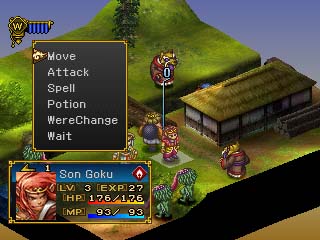 |
Saiyuki: Journey West - Retroview |
 |
Old Legends Never Die
By: Paul Koehler
| Review Breakdown |
| Battle System |
7 |
| Interface |
6 |
| Music/Sound |
6 |
| Originality |
5 |
| Plot |
7 |
| Localization |
9 |
| Replay Value |
5 |
| Visuals |
6 |
| Difficulty |
Easy |
| Time to Complete |
35-45 hours
|
|
| Overall |
 |
| Criteria
|
Many classic myths and legends have remained favorite stories throughout the ages because they help people identify with their most extreme traits, or they explain the unexplainable. Hsi Yu Chi (loosely translated into English as The Journey to Western Paradise) - is one of the most famous Chinese myths. Not only does it provide the roots of Akira Toriyama's Dragonball universe, it also provides the direct setting for one of the last tactical RPGs for the Sony PlayStation - Saiyuki: Journey West. Its release from Koei came and went with little fanfare, and as far as TRPGs go - there is little innovation or difficulty. Nevertheless, the game is a solid title that gives decent respect to a famous story - a credit to the lasting power of myth and legend.
How does a scrawny Buddhist monk travel by foot from a remote monastery in China to India through dangerous territory? He has the help of an intrepid cast of friends who join him on a dangerous mission sent from Buddha himself - and so begins the story of Sanzo and his quest to the Thunder Temple. Unlike other interpretations such as the anime series Gensomaden Saiyuki, the game stays relatively close to the original myth and keeps each character's personality predictable. Sanzo is the innocent but determined monk, and his companions make up the basis for a well rounded party - many of which possess the unique ability to change forms.
All playable characters but Sanzo possess the ability to "Werechange", and for a time they transform into a powerful beast capable of dealing special attacks. Each character can remain in Were form for a limited amount of time, and can only morph once per battle. The use of Werechanges is important in some battles - although all of the characters come with a well rounded arsenal of spells and weapons. Sanzo possesses the ability to summon Guardians that provide status boosts to the party, and can cast powerful spells. All of these facets and the ability to cancel previous moves make this a very simple game to play as far as TRPG's are concerned.

|
| Son Goku in Action
|
|
Status menus are easy to access for maintenance of the party's spells and items, many of which are purchased in various towns throughout the game. Each character has a standard style of weapon with varying characteristics - Hakkai has a large rake with wide attack area, and Ryorin a long spear with considerable thrusting range. Each of the characters can upgrade their weapons at a Smith located in the major towns, while many vendors carry a powerful array of spells and healing items. Dojos are available in most of the towns, and the party can train against groups of enemies for considerable experience gains. Central to the game as well is the Post, were the party can run errands for money, experience, and occasionally rare items. Running jobs with a Post is a great way to gain experience for the party, and it helps decrease the difficulty of the game even further.
Presented in a style similar to Final Fantasy Tactics - battles are the center of the game, and happen in environments as diverse as mountaintops, beachheads, and volcanoes. Like any good TRPG, not all battle objectives are to "defeat every enemy", and they relate directly to the plot. The battlefield can be viewed from multiple angles as well. As mentioned before, Saiyuki's battle system is very simple - and it allows players to cancel any previous movement (but not attack or spell).

|
| Preparation for Battle |
|
Unfortunately, some of the visuals for battle actions are lengthy, taking up to 20 seconds. The game does have an option to turn off those animations, and it speeds up battles considerably - but at the same time the difference is so huge that it makes the pace of the balance uneven. PlayStation games are capable of better graphics than what Saiyuki displays, but they are more than passable - especially with the face artwork that displays each character's emotions in conversation. Both the beginning and ending of the game have nice anime-style FMV sequences, and the interludes before each chapter of the game have voice narration.
While the narrator for those interludes does a fine job, the game could really do without the introduction song. Aside from that, the music is unremarkable - but not annoying, and it is all entirely appropriate for the story.
Credit goes to Koei's localization team for a very clean translation - no major errors were found, and this only helps players grasp the subject matter even better. In addition, it's a decently long title with a few secret quests and items hidden throughout. For veterans of TRPGs, Saiyuki is insultingly simple and can easily be beaten without completing all of the subquests. However, the game does justice to one of the most famous myths of all time - and as such proves that old legends never die.
| 









